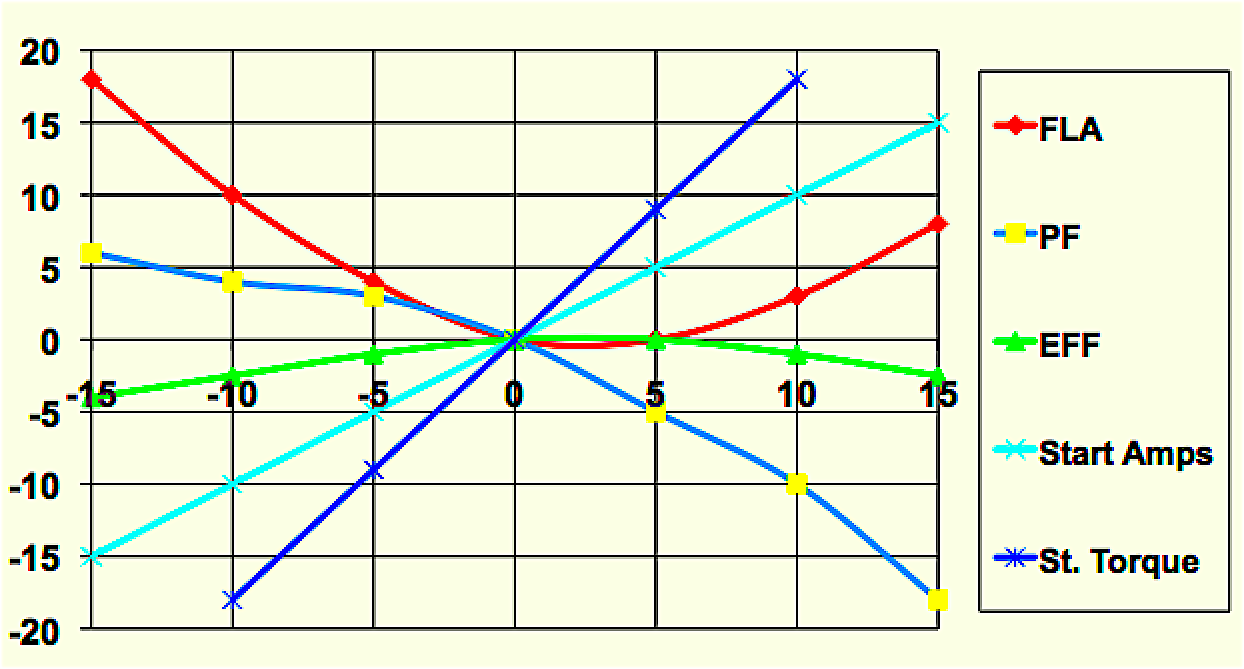As noted in previous articles in this series on motor-driven equipment and electrical-system-reliability issues in today’s plants, the primary electrical concern is the supply to electric motors, i.e., the voltage.
An electric motor is electrically designed around the expected supply voltage with a tolerance. With NEMA (National Electrical Manufacturers Association) designs for small- and medium-voltage electric motors is +/- 10% voltage-maximum, with an allowable +/-5% frequency variation (ref. NEMA MG1-2016 Section 12.44.1).
The nameplate rating of an electric motor identifies the nominal voltage at which the motor can operate. For instance, if the motor states 460 Volts, the limits at 60Hz +/-5% are 414V to 506V, and the motor will perform based upon these variations. As shown in Fig. 1, there will be impacts on the operating characteristics of the machine.

Fig. 1. Impact of Voltage variation
As outlined in the standard, the expected variations are in Full Load Amps (FLA), Power Factor (PF), Efficiency (EFF), Starting Current (Start Amps), and Starting Torque (St Torque). For instance, if the phase to phase measured voltage on the 460 Volt motor is measured at 486V, 492V, and 493V, the average is (486+492+493)/3 = 490V. The impact of this over-voltage is ((490V-460V)/460V)*100% = 6.5%. This variation results in a slight increase in FLA, a 5% reduction in PF, no significant change in EFF, a 5% increase in starting current, and a 10% increase in starting torque.
The variations are small (within the +/- 5% range). The U.S. Department of Energy (USDOE) recommends ensuring that voltage variation stays within 5% (ref. “Improving Motor and Drive System Performance: A Sourcebook for Industry” guidebook for energy and premium efficient electric motors). However, when the voltage is above or below the 10% value, the windings and rotor begin to overheat, and the result would be the appearance of an overloaded winding once the insulation system or bearings failed.
Voltage variation also becomes important with the application of variable-frequency drives (VFDs) and soft-start technologies. With a VFD, the Volts/Hz ratio is maintained as the applied frequency varies. The voltage must follow and the VFD allows the voltage to remain close to the optimal value. Soft starts will often use reduced voltage with the full-supply frequency, but for a brief period of time. The soft start uses the effects of reduced voltage on starting torque and other effects that reduce wear and tear on equipment.
For across-the-line equipment, if voltages are outside of the limits, then the taps on related transformers may be adjusted. It is important to ensure that changes on the transformer taps do not negatively impact other electrical systems such as lighting and controls. In addition to VFDs used to correct voltage and frequency, buck-boost transformers may be used to correct individual pieces of equipment.TRR
ABOUT THE AUTHOR
Howard Penrose, Ph.D., CMRP, is Founder and President of Motor Doc LLC, Lombard, IL and, among other things, a Past Chair of the Society for Reliability and Maintenance Professionals, Atlanta (smrp.org). Email him at howard@motordoc.com, or info@motordoc.com, and/or visit motordoc.com.
Tags: motors, VFDs, soft starters, voltage, power quality, electrical systems



